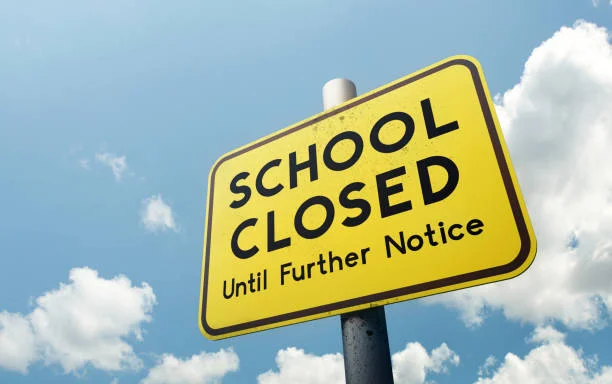In 2025, families across the United States are navigating a record number of weather-related school disruptions. Climate volatility, advanced forecasting technology, and real-time decision systems have transformed how districts announce closures, and how parents search for them. Whether it’s a blizzard sweeping through the Midwest or an air-quality alert over the West Coast, school cancellation alerts and district notifications now function like a public-safety system. Understanding how these decisions are made helps families prepare earlier, respond faster, and rely on more accurate sources.
Discover more insights that complement this topic—check out our related posts now!
How Extreme Weather Events Are Increasing School Disruptions
Extreme weather events, from atmospheric rivers to sudden polar vortices, are no longer outliers. Data from federal climate agencies shows a steady increase in storm severity and frequency, which directly affects school operations. Roads require more time to clear, power grids face greater strain, and districts must weigh safety concerns more urgently. This rise in climate instability has pushed weather closures to become more common, especially in regions once considered low-risk.
Why Parents, Students, and Districts Need Real-Time Closure Intelligence
With storms forming and shifting more quickly, the days of checking the morning news alone are over. Parents need advanced notice for childcare, transportation, and work planning. Districts depend on hyper-local data to assess hazards like temperature swings, bus-route viability, and campus infrastructure readiness. Students, meanwhile, rely on consistent messaging to know when to shift to virtual learning. Real-time closure intelligence, delivered through district apps, text alerts, and weather platforms, has become essential for community safety.
Why Sensor Tower Data Matters for School-Closure Search Behavior
Sensor Tower data matters for school-closure search behavior because it reveals real-time trends that show how families react to severe weather and shifting local forecasts. This data highlights keyword spikes, user intent patterns, and snow-day prediction interest, helping schools and news outlets understand behavior and optimize communication.
How Mobile App Demand Signals Reveal Surges in Weather-Related Queries
As storms approach, millions of families turn to their phones. Sensor Tower, a prominent app analytics platform, identifies spikes in downloads and usage of weather apps, district notification platforms, and emergency alert tools. These surges serve as a digital pulse check, indicating when communities expect closures long before any official announcement. They reflect a collective trend: When uncertainty rises, mobile search activity follows.
Rising Installs of Local Weather and District Alert Apps During Storm Cycles
During major weather events, downloads of local weather apps frequently increase by double or triple their weekly averages. Parents want precise radar data, not broad regional forecasts. District-branded apps also surge in new installs, especially in areas where push notifications serve as the first official communication. The pattern is clear: when storms intensify, so does mobile dependency.
Trust Signals: Why App-Based Behavior Predicts Closure Announcements
App behavior often mirrors local anxiety. When families rapidly increase screen time on alert platforms and weather dashboards, district leadership typically sees similar patterns on their internal analytics. These signals, combined with emergency management data, help forecast demand for closure information. Although they don’t replace official decisions, they reveal when communities expect disruptions long before the superintendent sends an early-morning email.
Read Next: Best Emergency Alert Apps for 2025 (href=”#”)
Methodology: How Search Trends, Mobile App Signals, and Weather Models Inform Closure Predictions
Strong closure predictions rely on search trends, mobile app signals, and weather models working together. These inputs reveal user intent shifts, real-time activity spikes, and local storm patterns, allowing closure predictions to become faster, more accurate, and more responsive than traditional forecasting.
2025 Snow Day Calculator Guide: Will School Be Closed Tomorrow?
The 2025 Snow Day Calculator predicts school closures by combining weather forecasts, snowfall totals, and historical closure data. It also integrates real-time search trends and district alerts to gauge community response. This tool helps families and educators plan ahead, offering a data-driven, reliable way to assess the likelihood of school being closed tomorrow due to snow or severe winter conditions.
Snow Day Prediction Tool: Calculate School Closure Probability in Your Area?
The Snow Day Prediction Tool estimates school closure probability by analyzing local weather patterns, snowfall forecasts, and historical closure trends. It also factors in real-time search activity and district alerts to provide accurate, data-driven predictions, helping families and schools plan ahead and respond quickly to potential snow-day disruptions.
Data Sources Used (NOAA storm forecasts, district alert systems, Sensor Tower app usage trends)
Predicting the likelihood of a school closure requires triangulating multiple data streams. NOAA’s storm forecasts offer scientific baselines: storm trajectory projections, snow and ice accumulations, and severe weather advisories. District alert systems provide insight into historical decision-making patterns. Sensor Tower trends add behavioral context through spikes in weather and emergency notification app activity. Together, these datasets create a multi-layered understanding of parent intent and district response.
How Query Frequency Indicates Parent and Student Intent
Search phrases like “Is school closed tomorrow?” or “weather closures near me” follow clear patterns. They spike 12–48 hours before a storm’s arrival, plateau during heavy precipitation, and taper once announcements become official. High-frequency queries across multiple geographic clusters often indicate rising concern and reflect early expectations of closures.
Limitations: Why No Model Can Confirm Closures Before District Approval
Even with sophisticated data streams, no predictive model can confirm a closure before district leadership signs off. Factors like bus staffing, building conditions, and local emergency coordination influence decisions more than public weather forecasts. Predictive indicators help families prepare, but official district notifications remain the only definitive source.
Data-Backed Indicators That Increase the Likelihood of School Closures
Data-backed indicators that increase the likelihood of school closures include rapid spikes in severe-weather searches, rising mobile app alerts, and escalating storm model confidence. These signals show heightened community concern, stronger forecast certainty, and growing disruption risks, making closures more predictable and easier to prepare for.
Snow Accumulation Thresholds and Road-Safety Metrics
Most northern districts maintain snow thresholds. For example, more than 6–8 inches overnight often triggers closure discussions. Rural districts with long bus routes tend to close earlier due to unplowed secondary roads. Even moderate snow can shut down operations if accompanied by rapid freezing or drifting.
Ice Storm Predictions and Bus Transportation Hazards
Ice remains the most dangerous factor for school transportation. A quarter-inch of freezing rain can immobilize bus fleets and turn sidewalks into hazardous zones. Unlike snow, ice does not require high accumulation to create high risk. Districts monitor road-surface temperatures and pre-dawn ice modeling closely when making decisions.
Wind Chill, Power Outages, and Infrastructure Vulnerabilities
Wind chill below -20°F or widespread power outages often force closures even without heavy precipitation. Heating systems, school generators, and safe walking routes all contribute to a district’s ability to remain open. Infrastructure vulnerabilities are especially concerning in older urban buildings.
App-Based Search Spikes as Real-Time Closure Signals
Real-time spikes in weather app usage and district notification logins often precede morning announcements. When thousands of families simultaneously check district apps at 5 a.m., it signals heightened expectation and heightened need for rapid communication.
Genre Trends: How Different Weather Types Influence Closure Probability
Different weather genres influence closure probability in unique ways, as heavy snow, freezing rain, and extreme wind each trigger distinct spikes in school-closure searches. These patterns show how hazard severity, storm timing, and road-impact risks shape decisions, helping districts anticipate closures with clearer, data-driven confidence.
Snowstorms & Blizzards: Highest Probability of District-Wide Closures
Blizzards remain the most common reason for full closures, especially when visibility drops below a quarter mile or snow accumulation exceeds plow capacity. These events often lead to early evening announcements.
Ice Events: Lower Precipitation, Higher Risk for Buses and Walkers
Ice storms cause fewer inches of precipitation but pose higher danger overall. Bus braking distances increase dramatically, making even short routes risky.
Thunderstorms & Tornado Watches: Short-Notice Closures and Delayed Starts
Severe thunderstorms, tornado watches, and high-wind advisories often result in surprise closures or midday dismissals. Storm timing plays a pivotal role. Early-morning outbreaks create the highest uncertainty.
Heatwaves & Air-Quality Alerts: Emerging Trend in Urban District Shutdowns
Heatwaves, combined with wildfire smoke and ozone alerts, have become growing closure drivers. Schools without modern HVAC systems struggle to maintain safe indoor temperatures and air quality, especially in large metro areas.
Regional Performance: How School Closure Likelihood Varies by Geography
School closure likelihood varies by geography because regions experience different storm intensities, road vulnerabilities, and community response patterns. Areas with frequent snow adapt faster, while warmer regions show sharper spikes in school-closure searches. These geographic signals reveal risk tolerance, infrastructure limits, and how weather impacts local decision-making.
Northern States: High Snowfall Tolerance but Strict Ice Protocols
States like Minnesota and Michigan rarely close for moderate snow thanks to robust plowing operations. However, ice events or power outages trigger swift cancellations.
Southern States: Lower Snow Preparedness and Faster Closure Decisions
In regions like Georgia or Texas, even an inch of snow or minimal freezing rain can shut down districts for safety. Limited snow-removal infrastructure amplifies risk.
Coastal Regions: Flooding and Storm-Surge Impacts on School Operations
East and Gulf Coast districts must prepare for flooding, storm surges, and high-tide road washouts. Evacuation routes near schools often dictate closure timing.
Mountain vs. Urban Districts: Infrastructure Gaps and Emergency Readiness
Mountain districts deal with heavy snowfall but often have adapted fleets and plow capacity. Urban districts face challenges tied to older infrastructure, heating reliability, and transportation density.
Developer Insights: What District App Developers and Alert Platforms Reveal
District app developers and alert platforms reveal critical behavioral signals, showing when parents check closure notices, how early they expect updates, and which weather triggers drive engagement. These insights highlight real-time user intent, notification performance, and system demand, helping schools refine closure timing and communication accuracy.
Push Notification Patterns Before Major Weather Events
Developers of school communication apps report noticeable increases in message scheduling during storm seasons. Districts often prepare drafts 24 hours before anticipated announcements.
Growth in Hyper-Local Alert Apps and Parent Adoption Rates
Hyper-local apps offering block-by-block weather and school notifications have grown significantly. Parents prefer precision, especially in microclimate regions.
How Developers Track User Engagement During Storm Cycles
Engagement metrics, logins, alert opens, and user heatmaps help districts understand when families are checking for updates. High activity clusters often precede official closures.
Conclusion: What to Do Now if You’re Checking Whether School Is Closed Tomorrow
If you’re checking whether school is closed tomorrow, monitor severe-weather searches, follow official district alerts, and track real-time app notifications. These signals reflect rising closure probability and help you prepare early, stay informed, and respond quickly as forecast confidence and community activity intensify.
Immediate Steps: District Website, Alert App, Local News
The fastest and most reliable source remains your district’s official alert system. Cross-check with local news, weather apps, and your district’s homepage.
Why Weather-Only Predictions Are Not Official Confirmation
Forecasts indicate risk, not decisions. Only district leadership can confirm closures, typically after consulting transportation officials and emergency management leaders.
Best Practices for Staying Prepared for Morning Announcements
Enable app notifications, keep devices charged, plan morning contingencies, and verify your preferred news sources. Preparedness matters, especially during unpredictable storm cycles.
FAQ: Weather-Related School Closures
What time do most school districts announce closures?
Most districts release decisions between 5:00 a.m. and 6:30 a.m., with some offering evening updates during major storms.
Can schools close even if the storm seems mild?
Yes. Mild storms can create dangerous road or sidewalk conditions, especially if temperatures drop suddenly.
Are after-school programs canceled automatically?
Not always. Some districts keep after-school programs open unless conditions worsen.
What’s the difference between a delay and a full closure?
A delay postpones the start time, often by two hours, while a closure cancels the entire day’s operations.
Who makes the final decision to close a school?
Superintendents, often in consultation with transportation teams and local emergency agencies.
Why do some districts close while neighboring ones remain open?
Conditions vary widely. One district may have hazardous roads or infrastructure challenges while another does not.
Explore our featured post for expert advice and standout ideas you’ll love.






